GW2: This time for sure?
My experiment with TSWL has come to a shuddering halt. While the stories and quests were on the whole quite strong, the relentless dark and gloomy environment in Kingsmouth eventually got to me (especially as it seemed that would be default atmosphere for the entire game). The combat being so lightweight bugged me, as did all the extra hammer blows I’d throw for no good reason after a mob was downed.
I tried Polaris with my friend, which was kind of fun but also weird. Being used to Warcraft dungeons, an empty instance with only a few mobs felt a bit half baked. We got stuck on one boss fight that was quite fun, but after zoning out I didn’t feel compelled to gear up and go back.
Different strokes for different folks though: that same friend is completely addicted and absorbed, the world building being right up his alley. It’s also his first MMO, so he’s probably gone for good - the first one gets hooks in deep.
Next I toyed with Warcraft again, going as far as making a solo guild on my old realm of Nagrand and reuniting all my higher level toons (all still level 100). This involved a few realm transfers, name changes, inventory shuffling, and bank reorganisation.
After all of which I couldn’t get motivated enough to head to Dalaran and start questing. I know better now than to question why Warcraft has this effect, so I logged off and searched for the next thing.
Luckily, the MMO air has been full of excitement about the impending GW2 expansion, Path of Fire. And GW2 has always been a game I’ve wanted to sink into, but never succeeded in getting past level ~10. A new expansion, hype, enthusiasm: if not now, when?
So I patched, researched professions, and decided to give a Guardian a go. First attempt was as a Charr, and much as I like the non human races in MMOs, their movement and hunched over stature just doesn’t work for me. Especially given how glorious some of the late armour models are, I feared the Charr would be a bit like the Tauren where the models don’t quite make the most of the epic design.
Next I tried an Asura, with similar problems, though this time it was more to do with their mechanical infatuation. I’ve always disliked the incursion of machinery and industry into a fantasy world - the Goblin race in Warcraft being a prime example. Their environmental destruction with smoke bellowing engines is hard to forgive, and the introduction of motorised vehicles is an abomination.
So, as usual in GW2, I fell back on the Norn. Don’t like the Elves, and humans are, well, human. So are the Norn I guess, but at least there’s something slightly different about them.
I tried a Guardian in the starter area, but was quickly put off by the fact that the 2nd and 3rd weapon skills aren’t weapons skills at all, but rather area-of-effect protective spells. It’s a bit dull having only one weapon animation and waiting while you place two zoned effects. I’d previously enjoyed the Warrior’s gung ho attitude, but also felt a bit like they didn’t offer anything special. So I settled on a Ranger. My Warcraft main is/was a Hunter, so I’m comfortable with the style, and was quickly sold on the Rapid Fire skill - great animation and sound, and much more satisfying than a circle on the ground. Plus the option of a pet makes solo exploring more companionable. could not find image
Of course as soon as I saw my first Charr and Asura I questioned my choice. Same when seeing the Warriors charging in with their insanely huge swords, or Guardians with that great armour and buffing everyone with glee.
I’ve finished up Wayfarer Hills, levelling to 16 on the way. One odd thing I’ve found is you rarely get gear upgrades. I was rocking my starter bow for a long time, and even now half my gear is white quality and ~10 levels lower than I am. I’ve purchased a few pieces from Karma vendors, but suspect that I’ll need to start crafting to make sure I’m staying up to speed. It was taking quite a while for on-level mobs to drop, which was strange after the OP combat of TSWL and Warcraft. I can’t join in the big debate about difficulty quite yet, as it seems the starter zone is as non-threatening as possible. The only fight that gave pause was an Elite boss that game at the end of a zone. The dynamic quest text suggested this was a group fight, and so it turned out to be. Two of us were attempting it, but it seemed we needed at least a couple more. The NPCs with us kept going down, and there was a new shield health bar on the boss that seemed to need some kind of interrupt to reduce.
I found Jeromai’s description of trying to ‘solve’ mechanics in the PoF demo fascinating, but trying to work it out on the fly I couldn’t see any skill I had that might help. We eventually had to abandon when after 20 minutes or so the mob wiped everyone but me, and promptly healed up to full again. Still, the fight didn’t seem unbalanced, more just a little over our heads (I came back later and a group of four managed to take it down with few problems).
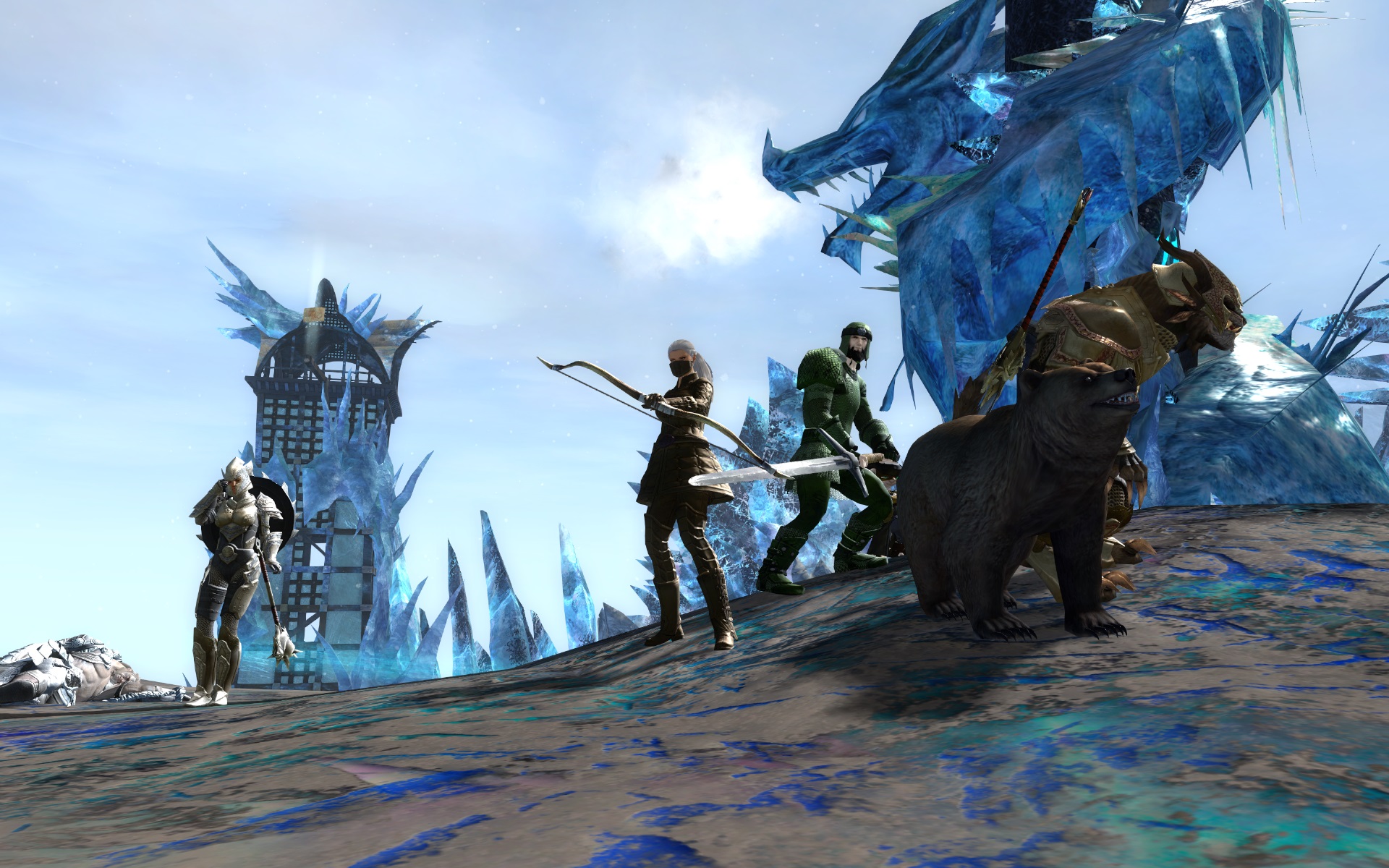
I think my bear would look good in that Charr armour
It was also interesting to find that despite GW2’s reputation of ‘play how you want’, I felt more or less led along a fairly predictable path. Follow the Hearts, seek out the Viewpoints and Points of Interest, find the Hero Challenges and Waypoints. It didn’t feel that different to a traditional quest hub style of game. Maybe that changes after the starter zones?
I also found it impossible to resist trying to get 100% zone completion. I read Bhagpuss’s warning that completionist gameplayers may suffer in GW2, but I found that collecting all the exploration goals was a good way of enjoying the zone. It really is a beautiful game to behold, and I was amazed by some of the underground architecture in particular, places I suspect 90% of the player base never ventures as they are slightly off the beaten track. So too the heights, though the Vista seeking means they are probably more commonly enjoyed.
Next up seems to be starting the Living Story, which people seem to rate pretty lowly. But who can resist a sparkling green map marker for long? Certainly not a (semi) completionist like me.
Secret World Legends: Massively single player
Having read a lot about The Secret World, I managed to miss out playing it completely by adding it to my Steam queue about 1 day before it was withdrawn for the rebirth as Legends. So I’ve come to the ‘new’ game completely blind, and untainted by expectation (other than the much lauded storyline) or experience. Which helps a lot when it comes to enjoying it without having to rue/farewell the good/bad old days.
I’ve levelled up to 10, and the most striking thing about it so far is how it plays like a single player game. While there have been other players, occasionally, for the most part it feels like a solo RPG. Mysteries, quests, power-ups, and a lot of (excellent) NPC dialogue. But not a lot of interaction with other players, nor seemingly any compelling reason to group up.
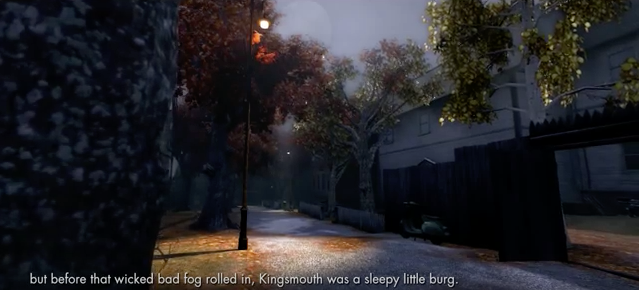
Admittedly that feeling of solo play started to change in Kingsmouth, but mainly due to world chat suddenly exploding into action. There’s too much chat to really pay attention, especially because the bulk of it is comparison talk - what’s better, what’s worse - but at least it proved there are other players out there. It does sound like group content is approaching - teams for ‘Polaris’ keep being advertised, so that’s promising.
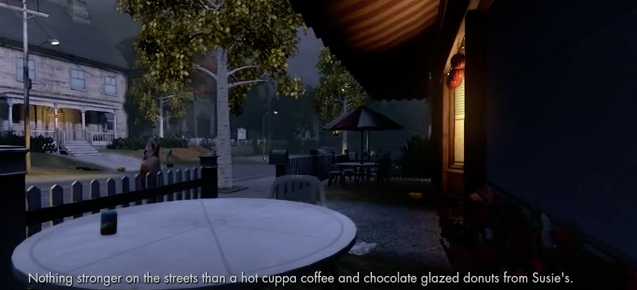
And I think at level 10 something flashed past on the screen about PVP? The UI leaves something to be desired - often I was being awarded something or other but couldn’t see it behind the quest completion or inventory UI. I also have no clue what I’m doing with skill upgrades or talent builds - so far I’ve ignored them and it hasn’t mattered at all.
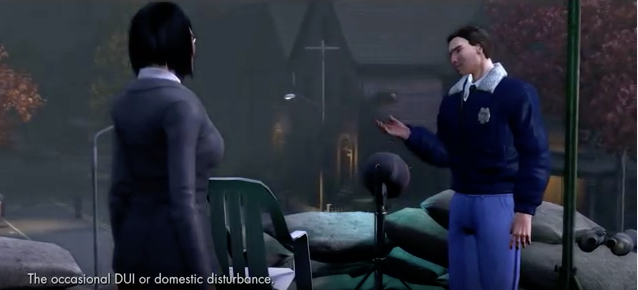
The combat is also pretty average, as advertised. I chose to roll Demolisher, liking the idea of a hammer-smashing sword-slashing tank, but there is zero ‘feel’ to the melee combat. It has no weight whatsoever, the hits don’t connect with any heft, and it seems that just mashing right and left mouse will do the job. Even with the world bosses, the only minor challenge has been to dodge the action telegraphs. The airiness, more than the clumsiness, of the combat is disappointing, even with low expectations.

As for the story, it’s certainly far more involved than Warcraft or GW2, approaching SWtoR in terms of craft and depth. SWtoR still wins hands down for the feeling of heroism, that you matter and your character is shaping epic events, but TSWL is proving to be a refreshing change to the fantasy and sci-fi tropes. Wry humour and well written NPCs, and an omnipresent tone of everything in the world being slightly - but not totally - off kilter.
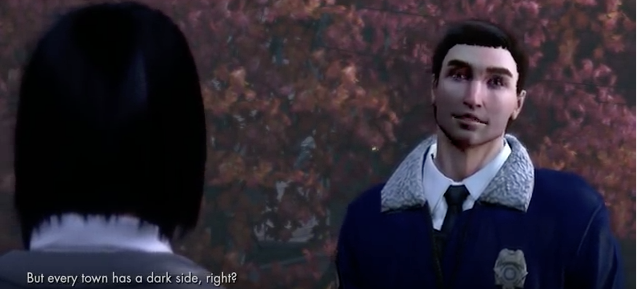
A friend is also playing, and it’s his first ever MMO. Which is kind of unfortunate as it’s hardly that thus far, but we’re going to team up and see what eventuates. More zombies, I’m guessing.
Warcraft: Back to Basics
After a fairly long break, the Warcraft itch returned recently. I haven’t played at all for months, having been dabbling around in Uncharted I (fun, quick, entertaining), play-by-email Civ VI (thanks to the genius behind Play Your Damn Turn), and Overwatch (still, though a lot less).
It become obvious the MMO urge was back when I started patching GW2, SWtoR, and even LotRO recently (without really playing any of them). I eventually admitted to myself that Warcraft was what I was really hankering for. In some ways this seemed kind of regressive, as Jeromai at Why I Game recently pondered - why do we continually return to the comfort of what we know when there is so much new to play out there? But then I think that comfort is part of the point - having invested enough time to really deeply understand a game, especially an MMO, makes playing it that much more satisfying.
The best answer is to balance your ‘main’ game with others, though sometimes an MMO makes that difficult, particularly if you’re raiding. If it was going to be Warcraft, I figured I wanted to start again (yet again). That seems to be a common pattern - come back and level 3 or 4 Tauren through Mulgore. I must have done that zone 100s of times. I love the feeling of openness, the rolling plains, Tallstriders, and wandering Kodo (never to be killed). I also love low level levelling, it’s so satisfying seeing new skills arrive that radically change your play style, as your character takes shape. Bhagpuss wrote it best in a lovely treatise on the joy of low level play:
There really is nothing to match the satisfaction, the involvement, yes, the immersion. Stepping out in rags with a rusty sword or a knobbled stick, making your way in a hard, harsh world, being useful, helpful and always, of course, violent. Learning a craft, finding a path, seeing your rags turn to riches or at least to leathers. Taming pets, earning mounts, flourishing your first cloak. Seeing your reputation rise. Watching the world open up around you. Making space to stash the treasures you find. Paying the rent on your first home and laying down the pelt of that great bear you slew, in front of a roaring fire you made all on your own.
As has been extensively discussed, one problem with low level play is that you quickly outzone the content, especially when decked out in heirloom gear. The ‘vanilla’ discussion is as lively as ever, but still seems unlikely to ever really happen (though the advent of Starcraft Remastered might be a glimmer of hope for the olde skool WoW fans).
So I decided to create my own vanilla, by creating a new account and playing the free level 1-20 Starter Edition. No heirlooms, no money, no bags, no speed running. And it was fun! The level progression is slower, though surprisingly not by much. Blizzard did to a revamp of low level quest pacing back in mid 2016, and it seems to work if you’re not over geared. I was right around the correct level for everything I was doing in Mulgore, even having to go and pick a few random herbs at one point to get high enough level to tame Mazzranache (though gosh the guilt at leaving little Hazzranache, Razzranache, Jazzranache, and Spazzranache orphaned is pretty bad). could not find image
There was still no challenge, everything dropping like flies (albeit with a few more hits than normal), but it was more fun having to watch every copper and celebrate every 6 slot bag drop (tip: kill the rares - except the sacred Kodo Arra’chea of course). Having no resources also made professions more interesting, and starting fishing from scratch was entertaining in a sadistic kind of way.
As usual I got to Thunder Bluff, and promptly found the idea of going any further kind of overwhelming. It’s a long path ahead, and some of the levelling zones have worn out their welcome. At this point I usually abandon my best intentions of zone and quest levelling and just dive into dungeons as a Tank, getting to Outland in no time by chain dungeoning. But this time that seemed wrong, these toons are not speed levellers[^1], they should stay the course, or just make a home in the Tauren capital and go no further.
So I’ve settled my well rounded level 15s in Thunder Bluff, and stopped again. The next decision is whether to resubscribe and get some toons to level 110 - mainly my Hunter and Rogue (the Rogue being my very first WoW character, still going). I’m sorely tempted, but then The Secret World Legends is intriguing, Dishonored 2 sits in the queue, and finishing Geralt’s journey in Witcher 3 is also a possibility. But I think getting at least someone at 110 is a good plan, and after all, more than one game at a time should be possible - or twelve, if you’re Syp!
[^1] Plus I’d have to make a financial commitment to get these characters past 20.
Overwatch Uprising: it’s over 9 thousand!
Thanks to a handy infographic published by Blizzard, we know that the two week PvE Uprising brawl in Overwatch racked up 145 million games during its stay. That’s a big number. Let’s break down the numbers.

The big picture
First of all we learn that the bad guys won more often than the goodies. That came as a surprise I think, but the reason is revealed a bit further down. Meanwhile:
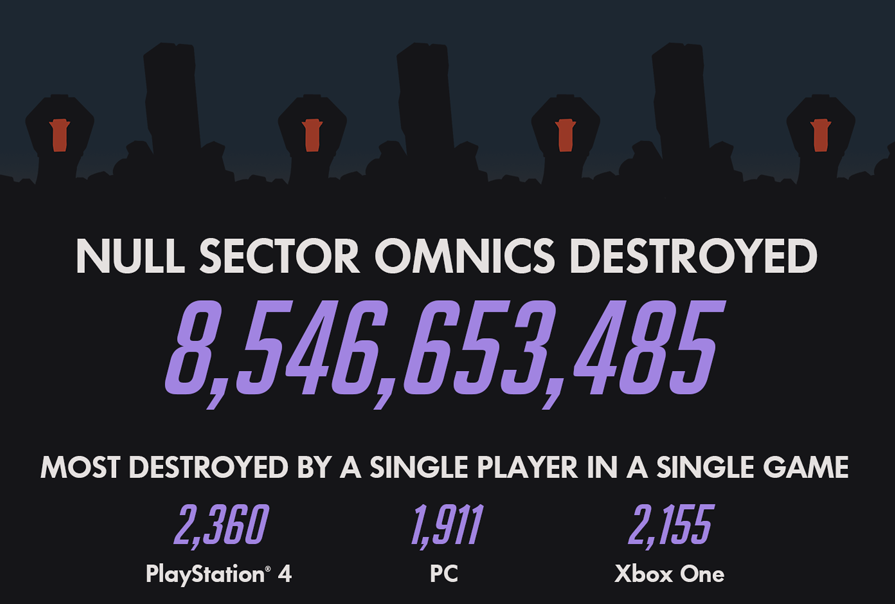
PC non-master race?
That’s an even bigger number. I almost feel sorry for the robots. But not for the confounded Bastion tanks in the last room - reason one for the Omnic’s racking up 11 million more victories. Next:
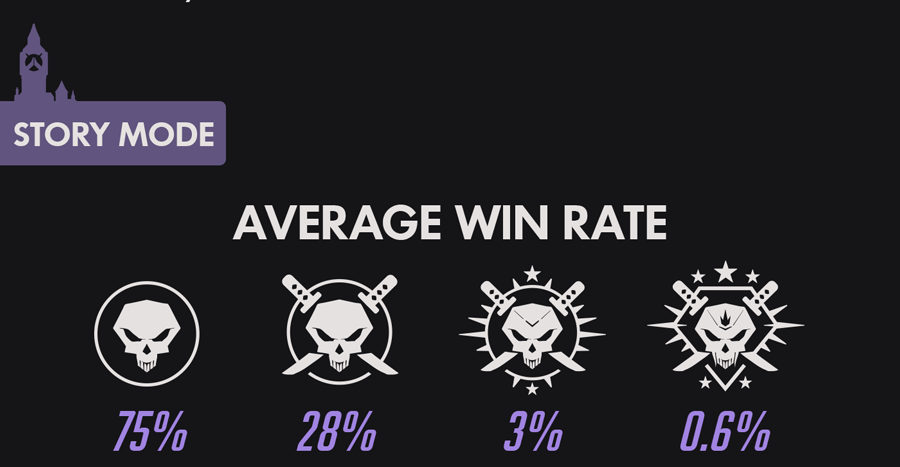
The truth is revealed
And there’s reason two. Legendary mode had a staggeringly low win-rate of 0.6%. This is the most interesting graphic of the whole thing, revealing that Blizzard aren’t afraid to completely stomp even their best players. The 50% drop off from Normal to Hard is also worth noting - it was a much more difficult ramp up than say the Normal/Heroic switch in Warcraft. After one success in Hard mode my random group of strangers stuck together to try Expert and we were completely annihilated, so I now understand why players screamed with triumph when they beat Legendary. Like winning ye olde Stranglethorn Fishing comp, but harder.
And finally:

Extrapolating
If my shaky maths is right, that’s over two billion minutes played. 2,415,405,127 to be precise1. 40 million hours. 1.5 million days. My brain is hurting. Fair to say Uprising was a success then. Time to go look at some nature. After just one more game.
-
Actually not precise at all, but close enough. ↩︎
Not so creative Ashes
The new MMO hotness - at least until the next Kickstarter - is Ashes of Creation, which has surpassed $1.5m in funding from hungry fans. That’s a lot of faith in an unseen digital product, especially when compared to something like the Weta Workshop Heavy Hitters Kickstarter which raised $935k for a very impressive looking boardgame.
The Kickstarter is pretty standard, offering beta access and various levels of shiny limited pixels for getting on board. Nothing terribly compelling, though two people have taken up the $10k ‘Avatar of the Phoenix’ pledge, so I guess a launch party in Vegas works for them. I’m not that interested in beta play, something I discovered once receiving the Crowfall beta invite. I dutifully installed, logged on, made a mighty minotaur, found an entirely empty world, and logged out again. Haven’t been back, but I like the idea being able to once things get a bit more interesting.
Having become intrigued by AoC based on their node hype videos, it was surprising to find that the Kickstarter actually made me less inclined to support the game. Which I’m sure wasn’t the intended effect. The main problem is the incredibly boring race options. Bhagpuss sums it up perfectly:
There’s quite a lot of new information (or at least new to me) on the game itself. It details the eight races and the eight class archetypes for a start. Boy, do they look bland. When I heard they were starting with eight races I was hoping for the chance to play something other than the usual: human, human with pointy ears, ugly human or short human. Ashes of Creation gives you Human, Elf, Orc and Dwarf. So much for that, then. Also, splitting your four races in two does not give you eight races. Just sayin'.
Precisely. Like SWtoR before it, AoC has taken a fantasy world that could be populated with literally any kind of creature, and given us a choice of four humans. So dull! Our only hope for something different comes from the just revealed $2.5m stretch goal, which teases of a mysterious ‘beast like’ Underrealm race.

Some kind of…shadow monster? With a tail?
Less worrying, but still kind of blah, are the character classes, which fit every archetype like a glove, with little imagination. They even go so far as to name the tank class a…‘Tank’. I only wish they had gone the whole hog and called the healer ‘Heals’. I’m kind of hoping they are reverting to some kind of vanilla MMO basics in order to reinvent the whole paradigm. The pedigree of the team would support that admittedly hopeful hypothesis.
Speaking of the team, it’s a little concerning to see the 13 person team includes all of one woman, and she is (of course) the Community Manager. Which is a vitally important role, but it reeks of the (still sadly true) corporate cliche of the only woman on the management team being from HR.
Despite all that, I happily jumped on board at the second lowest tier. Friends asked what was the point of Kickstarting (and Syp asked himself the same question, and that’s a valid question given the sub model. For me it’s worth backing these things just for the gentle entertainment of seeing progress and updates and vaguely participating in the entire process of making a game. Once the inevitable mid-development malaise sets in, I’ll just be skimming - or more like ignoring (hi, Crowfall) - the email spam.
But then will come that magical day when we can logon to a brand new world and see what wonders and mysteries it reveals. Worth $40, easy.